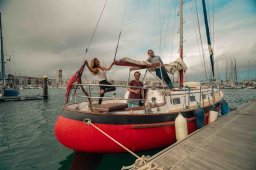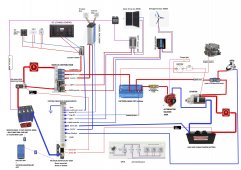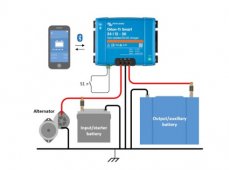Dijo
New Member
- Joined
- Jul 6, 2021
- Messages
- 27
Hello community!
After some long sail trip on some friend’s boats , I've bought recently an old 1978 (picture below) . I'm planning to re-new the boat entirely, then leave the canaries islands to sail around the world. Goal is to live off-grid, going surfing everywhere, trying to be self-sufficient as much as we can..
 Picture of the beautiful Valiant 32 with this amazing canoe stern butt
Picture of the beautiful Valiant 32 with this amazing canoe stern butt
After reshaping the windows, varnishing and renewing all wood , made the hull brand new, made all the plumbing.. I’m now into electricity.. which seems to be the last part before upgrading the living area..
I’ve made the schema below. but I don’t know what I am doing. I’ve learned a lot during my sailing experience. I have even made some upgrading on some boat system. I’ve read a lot and try to understand electricity .. but I’ve never made and design an entire system by myself.
Schema of the new electrical system : (explanation below)

Explination for the all system :
I don’t have a lot of money, so I would like to re-use what I had before when we were roots sailing to test the boat..
I had : -1x Flexible 100W solar panel – solar controller PWM 35A – 1x LA 110ah battery..
to re-use all of this and not mix battery type, I’ve made choice to have 2 différents circuit :
-Circuit 1 : The beautiful Service battery bank 2 pack of 200ah lifepo4 + 2x200W solar panel + 400w Windgenerator
-Circuit 2 : The classic Engine starter 110aH LCA + 1x100W flexible solar panel (panel and PWM are not shown on schema)
Solar panel will be mounted on an arch (which will be made before the electrical installation) and would have a variable positioning orientation.
Flexible solar panel will be or on the side line or on the deck..
Windgenerator will be on a pole above the arch but won’t be mounted directly. just because they are super expensive, I will wait to find a good buying opportunities or even intempting to build-one using the low tech technologie… but for the now, solar panels and alternator will be the only one to charge.. and with my total consumption calculation, it will be enough. I will have some backup days (2) just in case there is no sun , and if solar won’t be enough I will turn the engine sometimes..
Concerning grounding :
i've grounded for both system on the same busbar.. should i separate grounding ? add an extra central negative busbar for Sarter circuit ? or even ground everything dirrectly on the engine chassi ?
Concerning the alternator
I’ve learned there is a gear call “ARGO FET” from Victron, FET isolators allow simultaneous charging of two or more batteries from one alternator (or a single output battery charger), without connecting the batteries together.
this is exactly what I needed, I wanted to be able to charge both circuit with my alternator. So, I integrated in the scheme. is everyone already using this ?
Concerning the alternator. I have a Balmar 100A which seems a good one. It was on the engine already when I bought it.. But it appeared whenever I connected to the battery , it gave 18V.. looks like the regulator is dead, or there is no regulator at all on those model.. (I guess it’s an old model from balmar because I couldn’t find it)
I’ve seen on balmar website , there is some external regulator for those alternator, but they are so expensive, almost 800$ for it. Insane!
I don’t know the ARGOFET, but do the Argo has an regulator integrated for the alternator ? or do I have to put an external alternator regulator between alternator and Argo ? or add an internal regulator ?
After researching on the forum, I’ve found The VSR alternator regulator. (good article on this here http://arduinoalternatorregulator.blogspot.com/) they are much cheaper than Balmar one… Would this regulator be enough and are reliable ? anyone using this ?
Is those VSR alternator would be enough to protect batteries but also the alternator? or Should I put a SERTLING pro protect alternator protection switch to protect any alternator damage ?
Concerning the AC distribution
On a money concern, I’ve made the decision to save some money on the AC-DC charger. I think with this setup of 2x200a lifepo4 , a good solar array working with a good wind generator and alternator, I won’t need to connect to the grid to charge my batteries.. But I could upgrade and put a charger, in the future when I will have the money. or not.
AC circuit will only consist with plugging on the grid and have some working AC plug in the boat while in the marina...
Concerning the control tools
As showing on the schematic drawing I will have 2 app on my dedicated iPad for the boat. Ipad will mainly be use as a plotter and monitoring batteries :
- BMS APP to control the cells charge balance
- Victron smart shunt APP with the coolest feature to monitor 2 different batteries..(as shown in Will Prowse’s video)
-the MT50 + T°C sensor from the EPEVER 40A as a controller in the living area.
Concerning LIFEPO4 BMS
I’m still wondering which BMS I should use on each pack. 2x overkill 120A or 2x Daly 200A? I think with 2 overkill I would be able to draw 260A on a peak discharge. and with a 2000W inverter, those BMS will handle it ?
Concerning the Inverter
the only use of the inverter will be to charge and plug my computer, and charge some camera batteries. for any AC tools, I guess I will always wait to be in the arbor to use it..
I’ve made the choice of 2000W only to oversize it and avoid any heat damage. but maybe only a 1500W will be enough. maybe even a Victron 500W could be enough ? and maybe if I reduce the inverter I could also reduce the BMS and put the money into a good solid BMS like the overkill 120A ..
I know it’s a lot of interrogation, I’ve tried to be as clear as I could be ..
Anyway, i would love to heard what you have to say about this schematical drawing. Where I’ve overlooked, where i could upgrade it.. if I made some mistake in the drawing…
should the system work like that, what could I do better?
What could I do differently to save some money? I don’t want to save some money on good component, but maybe designing the system in another way , will reduce some costs.. let me know.
Otherwise, I will be in the canaries for some time, I guess until mid-October, so if anyone is there and want to catch up to have some nice discussion about the sailboat life, it will be with pleasure !
I wish you all some good time !
Let’s discuss !
After some long sail trip on some friend’s boats , I've bought recently an old 1978 (picture below) . I'm planning to re-new the boat entirely, then leave the canaries islands to sail around the world. Goal is to live off-grid, going surfing everywhere, trying to be self-sufficient as much as we can..
 Picture of the beautiful Valiant 32 with this amazing canoe stern butt
Picture of the beautiful Valiant 32 with this amazing canoe stern buttAfter reshaping the windows, varnishing and renewing all wood , made the hull brand new, made all the plumbing.. I’m now into electricity.. which seems to be the last part before upgrading the living area..
I’ve made the schema below. but I don’t know what I am doing. I’ve learned a lot during my sailing experience. I have even made some upgrading on some boat system. I’ve read a lot and try to understand electricity .. but I’ve never made and design an entire system by myself.
Schema of the new electrical system : (explanation below)

Explination for the all system :
I don’t have a lot of money, so I would like to re-use what I had before when we were roots sailing to test the boat..
I had : -1x Flexible 100W solar panel – solar controller PWM 35A – 1x LA 110ah battery..
to re-use all of this and not mix battery type, I’ve made choice to have 2 différents circuit :
-Circuit 1 : The beautiful Service battery bank 2 pack of 200ah lifepo4 + 2x200W solar panel + 400w Windgenerator
-Circuit 2 : The classic Engine starter 110aH LCA + 1x100W flexible solar panel (panel and PWM are not shown on schema)
Solar panel will be mounted on an arch (which will be made before the electrical installation) and would have a variable positioning orientation.
Flexible solar panel will be or on the side line or on the deck..
Windgenerator will be on a pole above the arch but won’t be mounted directly. just because they are super expensive, I will wait to find a good buying opportunities or even intempting to build-one using the low tech technologie… but for the now, solar panels and alternator will be the only one to charge.. and with my total consumption calculation, it will be enough. I will have some backup days (2) just in case there is no sun , and if solar won’t be enough I will turn the engine sometimes..
Concerning grounding :
i've grounded for both system on the same busbar.. should i separate grounding ? add an extra central negative busbar for Sarter circuit ? or even ground everything dirrectly on the engine chassi ?
Concerning the alternator
I’ve learned there is a gear call “ARGO FET” from Victron, FET isolators allow simultaneous charging of two or more batteries from one alternator (or a single output battery charger), without connecting the batteries together.
this is exactly what I needed, I wanted to be able to charge both circuit with my alternator. So, I integrated in the scheme. is everyone already using this ?
Concerning the alternator. I have a Balmar 100A which seems a good one. It was on the engine already when I bought it.. But it appeared whenever I connected to the battery , it gave 18V.. looks like the regulator is dead, or there is no regulator at all on those model.. (I guess it’s an old model from balmar because I couldn’t find it)
I’ve seen on balmar website , there is some external regulator for those alternator, but they are so expensive, almost 800$ for it. Insane!
I don’t know the ARGOFET, but do the Argo has an regulator integrated for the alternator ? or do I have to put an external alternator regulator between alternator and Argo ? or add an internal regulator ?
After researching on the forum, I’ve found The VSR alternator regulator. (good article on this here http://arduinoalternatorregulator.blogspot.com/) they are much cheaper than Balmar one… Would this regulator be enough and are reliable ? anyone using this ?
Is those VSR alternator would be enough to protect batteries but also the alternator? or Should I put a SERTLING pro protect alternator protection switch to protect any alternator damage ?
Concerning the AC distribution
On a money concern, I’ve made the decision to save some money on the AC-DC charger. I think with this setup of 2x200a lifepo4 , a good solar array working with a good wind generator and alternator, I won’t need to connect to the grid to charge my batteries.. But I could upgrade and put a charger, in the future when I will have the money. or not.
AC circuit will only consist with plugging on the grid and have some working AC plug in the boat while in the marina...
Concerning the control tools
As showing on the schematic drawing I will have 2 app on my dedicated iPad for the boat. Ipad will mainly be use as a plotter and monitoring batteries :
- BMS APP to control the cells charge balance
- Victron smart shunt APP with the coolest feature to monitor 2 different batteries..(as shown in Will Prowse’s video)
-the MT50 + T°C sensor from the EPEVER 40A as a controller in the living area.
Concerning LIFEPO4 BMS
I’m still wondering which BMS I should use on each pack. 2x overkill 120A or 2x Daly 200A? I think with 2 overkill I would be able to draw 260A on a peak discharge. and with a 2000W inverter, those BMS will handle it ?
Concerning the Inverter
the only use of the inverter will be to charge and plug my computer, and charge some camera batteries. for any AC tools, I guess I will always wait to be in the arbor to use it..
I’ve made the choice of 2000W only to oversize it and avoid any heat damage. but maybe only a 1500W will be enough. maybe even a Victron 500W could be enough ? and maybe if I reduce the inverter I could also reduce the BMS and put the money into a good solid BMS like the overkill 120A ..
I know it’s a lot of interrogation, I’ve tried to be as clear as I could be ..
Anyway, i would love to heard what you have to say about this schematical drawing. Where I’ve overlooked, where i could upgrade it.. if I made some mistake in the drawing…
should the system work like that, what could I do better?
What could I do differently to save some money? I don’t want to save some money on good component, but maybe designing the system in another way , will reduce some costs.. let me know.
Otherwise, I will be in the canaries for some time, I guess until mid-October, so if anyone is there and want to catch up to have some nice discussion about the sailboat life, it will be with pleasure !
I wish you all some good time !
Let’s discuss !
Last edited:




